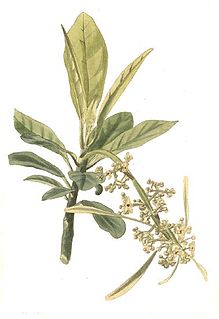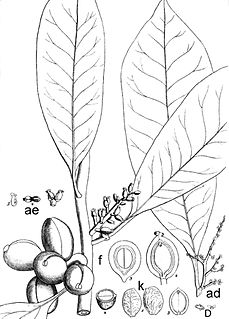
Omphalea is a plant genus of the family Euphorbiaceae first described as a genus in 1759. It is native to tropical parts of the Americas, the West Indies, Asia, Australia, and Africa.
Claoxylopsis is a plant genus of the family Euphorbiaceae, first described as a genus in 1939. The entire genus is endemic to Madagascar.
- Claoxylopsis andapensisRadcl.-Sm.
- Claoxylopsis perrieriLeandri
- Claoxylopsis purpurascensRadcl.-Sm.
Amyrea is a plant genus of the family Euphorbiaceae first described as a genus in 1941. It is native to Madagascar and to nearby Mayotte Island in the Indian Ocean.
Argomuellera is a genus of plant of the family Euphorbiaceae first described as a genus in 1894. It is native to sub-Saharan Africa, Madagascar, and the Comoros Islands.
Benoistia is a genus of shrubs or trees of the spurge family (Euphorbiaceae) and the monotypic subtribe Benoistiinae. It was first described as a genus in 1939. The entire genus is endemic to Madagascar. It is dioecious.
- Benoistia orientalisRadcl.-Sm. - N + E Madagascar
- Benoistia perrieriH.Perrier & Leandri - Madagascar
- Benoistia sambiranensisH.Perrier & Leandri - N Madagascar
Pantadenia is a genus of plants under the family Euphorbiaceae first described as a genus in 1925. It is native to Madagascar and Indochina.
- Pantadenia adenantheraGagnep. - Cambodia, Laos, Thailand, Vietnam
- Pantadenia chauvetiae(Leandri & Capuron) G.L.Webster - Madagascar
- Pantadenia gervaisiiR.Rabev. & McPherson - Madagascar
Leptonema is a genus of flowering plant belonging to the family Phyllanthaceae first described in 1824. The entire genus is endemic to Madagascar. It is dioecious, with male and female flowers on separate plants.
- Leptonema glabrum(Leandri) Leandri
- Leptonema venosum(Poir.) A.Juss.

Securinega is a genus of plants in the family Phyllanthaceae, first described as a genus in 1789. As presently conceived, the genus is native to Madagascar and the Mascarene Islands in the Indian Ocean. In the past, it was considered to be much more widespread, thus explaining the long list of species formerly included. It is dioecious, with male and female flowers on separate plants.
- Securinega antsingyensisLeandri - W Madagascar
- Securinega capuroniiLeandri - W Madagascar
- Securinega durissimaJ.F.Gmel. - Madagascar, Mauritius, Réunion, Rodrigues Island
- Securinega perrieriLeandri - W Madagascar
- Securinega seyrigiiLeandri - W Madagascar
Lingelsheimia is a plant genus variously classified in the families Putranjivaceae or Phyllanthaceae, first described as a genus in 1909. It is native to central Africa and Madagascar.
- Lingelsheimia abbayesii(Leandri) Radcl.-Sm. - Madagascar
- Lingelsheimia ambigua(Leandri) Radcl.-Sm. - Madagascar
- Lingelsheimia fiherenensis(Leandri) Radcl.-Sm. - Madagascar
- Lingelsheimia frutescensPax - Gabon, Zaire
- Lingelsheimia manongarivensis(Leandri) G.L.Webster - Madagascar
- Lingelsheimia sylvestris(Radcl.-Sm.) Radcl.-Sm. - Tanzania

Didymeles is a genus of flowering plants. It is variously treated as the only genus of the family Didymelaceae — or in the family Buxaceae, as in the APG IV system.
Euphorbia pellegrinii is a species of plant in the family Euphorbiaceae. It is endemic to Madagascar. Its natural habitat is subtropical or tropical dry lowland grassland. It is threatened by habitat loss.

Laportea is a genus of plants in the family Urticaceae. They are herbaceous, either annual or perennial. Like many plants of the Urticaceae, they have stinging hairs. There are stinging and non-stinging hairs on the same plant. The genus was named after the French naturalist Francis de Laporte de Castelnau.

Treculia is a genus of trees in the plant family Moraceae that is native to west and central Africa and Madagascar. The best-known member of the genus, Treculia africana, commonly known as the African breadfruit, is used as a food plant.
Jacques Désiré Leandri, born 1903 in Corsica, died 1982, was a French botanist and mycologist.
Paul Auguste Danguy was a French botanist.
Atemnosiphon is a genus of flowering plants belonging to the family Thymelaeaceae.
Capuronia is a genus of flowering plants belonging to the family Lythraceae.
Leandriella is a genus of flowering plants belonging to the family Acanthaceae.
Stephanodaphne is a genus of flowering plants belonging to the family Thymelaeaceae.
Humbertiodendron is a monotypic genus of flowering plants belonging to the family Trigoniaceae. The only species is Humbertiodendron saboureaui.




